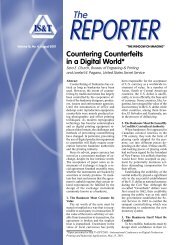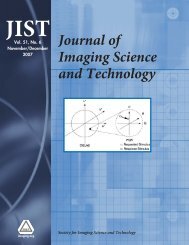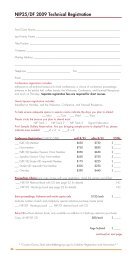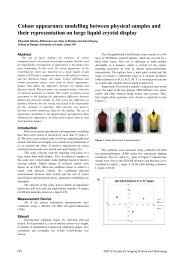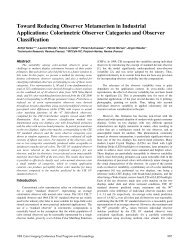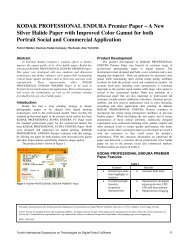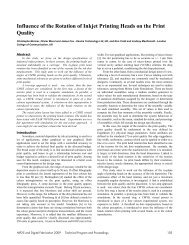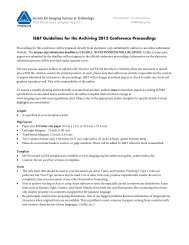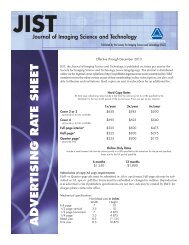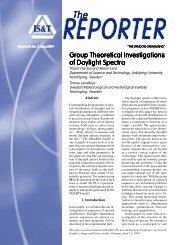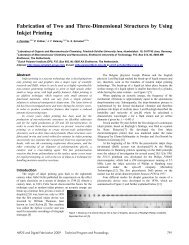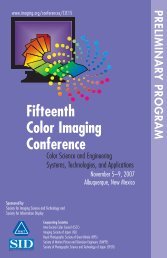JIST - Society for Imaging Science and Technology
JIST - Society for Imaging Science and Technology
JIST - Society for Imaging Science and Technology
You also want an ePaper? Increase the reach of your titles
YUMPU automatically turns print PDFs into web optimized ePapers that Google loves.
Hasan, Filosa, <strong>and</strong> Hinz: Effects of molecular substituents of copper phthalocyanine dyes on ozone fading<br />
Table I. Effects of ozone exposure on C, M, Y densities of printed images of CuPC dyes<br />
Dyes Density DC DM DY<br />
CuPC-A Initial 1.22 0.23 0.10<br />
After exposure 0.46 0.15 0.26<br />
Ratio, final/initial % 38 65 260<br />
CuPC-B Initial 1.20 0.31 0.25<br />
After exposure 1.19 0.31 0.26<br />
Ratio, final/initial % 99 100 104<br />
CuPC-C Initial 1.20 0.30 0.20<br />
After exposure 0.82 0.24 0.28<br />
Ratio, final/initia% 68 80 140<br />
Figure 5. Ozone induced spectral changes in thermally transferred images<br />
of CuPC-A <strong>and</strong> CuPC-C.<br />
CuPC-D Initial 1.15 0.30 0.20<br />
After exposure 0.80 0.23 0.26<br />
Ratio, final/initial % 70 77 130<br />
Table II. Effects of ozone exposure on L * , a * , <strong>and</strong> b * values of printed images of CuPC<br />
dyes.<br />
Dyes L * a * b *<br />
CuPC-A Initial 68.82 −45.86 −38.88<br />
Final 81.12 −27.49 −1.29<br />
Change 12.30 18.37 37.59<br />
CuPC-B Initial 62.78 −46.42 −30.19<br />
Final 62.75 −46.43 −29.81<br />
Change −0.03 −0.01 0.38<br />
Figure 6. Ozone induced spectral changes in thermally transferred images<br />
of CuPC-A <strong>and</strong> CuPC-D.<br />
CuPC-C Initial 63.73 −45.35 −36.36<br />
Final 70.45 −41.70 −16.59<br />
Change 6.72 3.65 19.77<br />
CuPC-D Initial 64.56 −44.71 −34.32<br />
Final 70.88 −40.31 −17.96<br />
Change 6.32 4.40 16.36<br />
A comparison of gradual cyan density loss with time of<br />
printed images of CuPC dyes due to exposure to ozone over<br />
an extended period of time is shown in Figure 7. The<br />
CuPC-A image shows 15% retention after 8.5 h of exposure,<br />
whereas the most stable CuPC-B image retains 73% of the<br />
initial cyan density under identical conditions. The other<br />
two dyes, CuPC-C <strong>and</strong> CuPC-D show much less density<br />
retention than CuPC-B, but are slightly more stable than<br />
CuPC-A. These results show the same trend in ozone stability<br />
of the CuPC dyes as observed after 1h of ozone<br />
exposure.<br />
The data indicate that the ozone stability of CuPC-B,<br />
containing allyl substituents, are considerably greater than<br />
that of the butyl or diethoxyethyl substituted CuPC-C <strong>and</strong><br />
CuPC-D dyes. As discussed be<strong>for</strong>e, a comparison of the<br />
spectra of the four dyes shows that greater extent of<br />
H-aggregation as indicated by the blue shift in the spectrum<br />
of CuPC-B, may be associated with the observed ozone stability.<br />
The spectra of the control CuPC-A dye <strong>and</strong> the synthesized<br />
dyes, dissolved in methylene chloride, do not show<br />
any such difference. It is possible that the planar allyl groups<br />
facilitate the required rearrangement of the molecules to<br />
cause such aggregation more than the other substituents <strong>and</strong><br />
result in a more stable <strong>for</strong>m of dye in solid state, as in a<br />
transferred image. In addition, the allyl groups may also<br />
react with ozone <strong>and</strong> act as ozone scavengers, thus protecting<br />
the chromophore.<br />
CONCLUSIONS<br />
Difference in molecular substituents of copper phthalocyanine<br />
dyes produces large effects on ozone fading of the<br />
printed images. Images <strong>for</strong>med with the allyl substituted dye<br />
show greater ozone stability than those with butyl or<br />
diethoxyethyl substituted dyes. The allyl substituted dye also<br />
422 J. <strong>Imaging</strong> Sci. Technol. 515/Sep.-Oct. 2007




